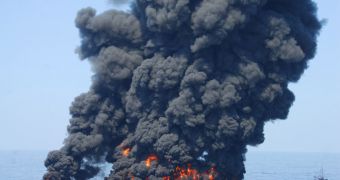About 0.5 percent of all oil that was dumped in the Gulf of Mexico during the 2010 BP/Deepwater Horizon Gulf oil spill – the equivalent of 1 in 20 barrels – was burned during the first days of response to the emergency. A new study quantifies the effects this decision had on the environment.
As the massive oil rig collapsed and sunk, it triggered one of the largest spills ever recorded. During the efforts to reduce the spread of oil slicks, authorities intentionally set fire to some of the oil, creating billowing clouds of smoke made out of black carbon (soot) and other hazardous chemicals.
Science flights conducted through the plumes with the US National Oceanic and Atmospheric Administration's (NOAA) WP-3D aircraft measured soot concentrations and quantities in these clouds. Now, experts publish the detailed results of the investigations they conducted during those days.
According to results, more than 1 million pounds (around 453,000 kilograms) of soot were released into the atmosphere. The data establishing these numbers were collected by NOAA in June 2010.
The advanced single-particle soot photometer aboard the WP-3D provided individual soot particle characterizations, which came in handy for researchers trying to establish their influence on the environment above the Gulf of Mexico.
The investigation was conducted by experts at NOAA and the Cooperative Institute for Research in Environmental Sciences (CIRES), in Boulder, Colorado. The work appears in this week's issue of the esteemed journal Geophysical Research Letters.
Researchers say that the soot released during the intervention is equal to the total black carbon emissions released by all ships traveling the busy shipping lanes in the Gulf over 9 weeks. Soot is known to contribute to the greenhouse effect and global warming.
“Scientists have wanted to know more about how much black carbon pollution comes from controlled burning and the physical and chemical properties of that pollution. Now we know a lot more,” CIRES researcher and lead study author Anne Perring explains.
She is also a researcher at the NOAA Earth System Research Laboratory (ESRL) Chemical Sciences Division, also in Boulder. The expert explains that exposure to soot causes long-term health problems in humans, including an increase in the incidence of respiratory diseases.
“The size and makeup of the black carbon particles determine how fast the particles are removed from the atmosphere by various processes, which ultimately affects their impact on climate,” Perring concludes.

 14 DAY TRIAL //
14 DAY TRIAL //